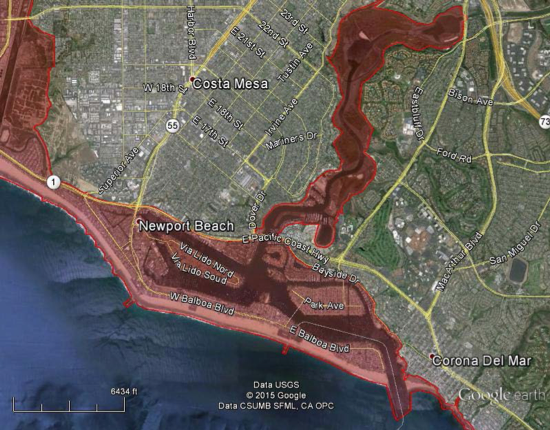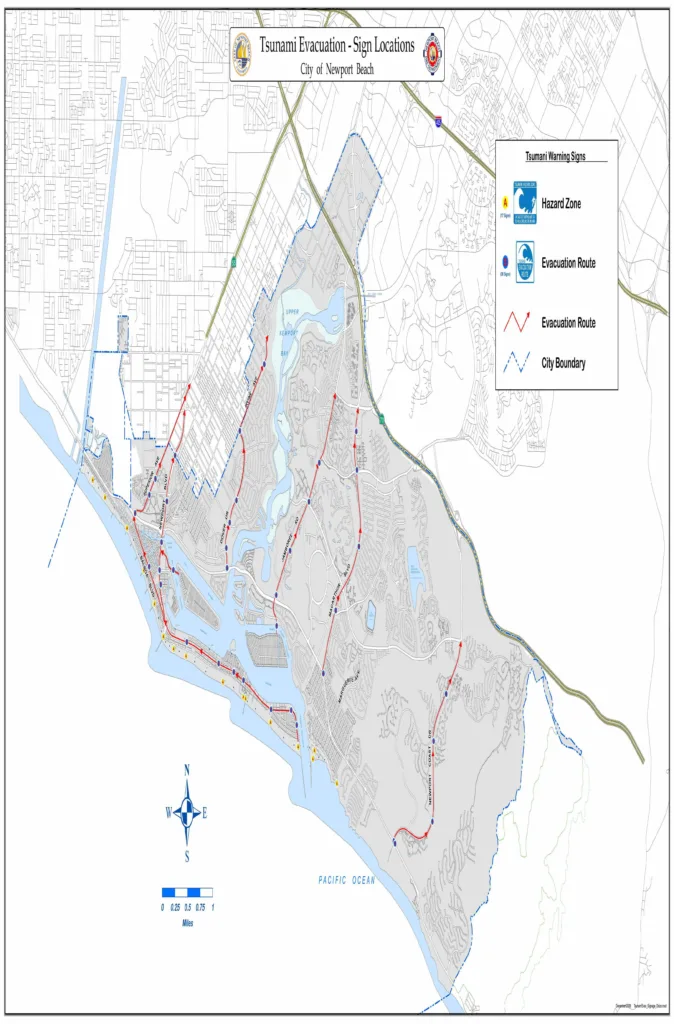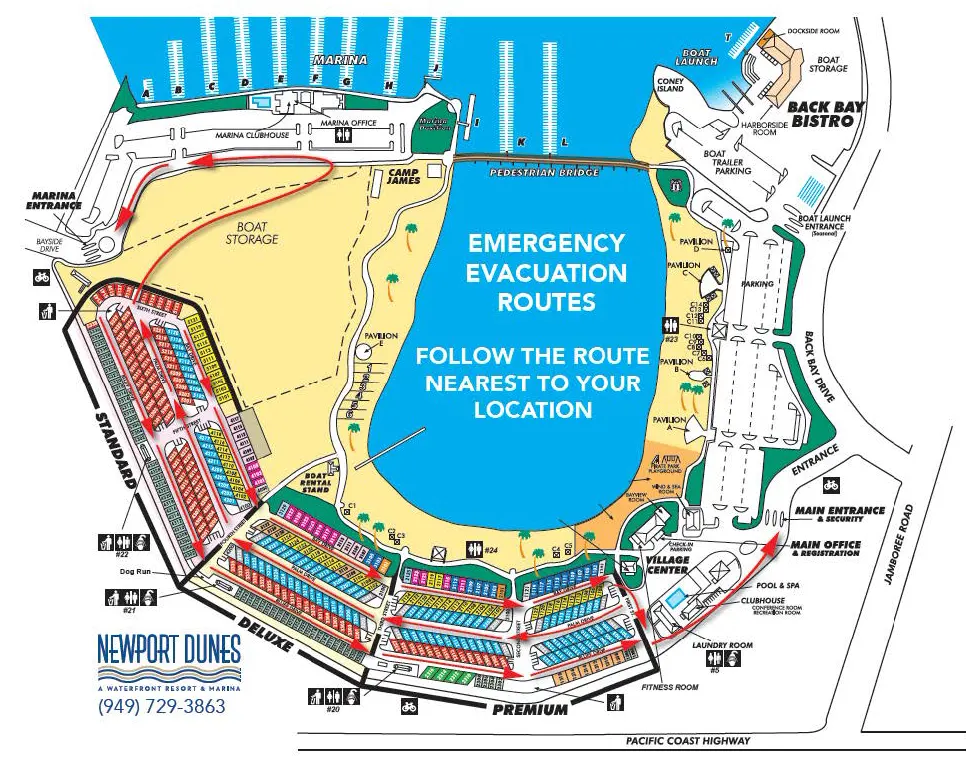Newport Dunes Resort Emergency Evacuation and Preparedness Plan
Our Newport Dunes Evacuation & Preparedness Plan provides helpful information in case of emergency.
List of emergency phone numbers:
Emergency Services: 911
Newport Dunes Waterfront Resort & Marina Emergency Line: 949-999-3151
Newport Beach Police Department: 949-644-3681
Newport Beach Fire Department: 949-644-3104
Orange County Sheriff’s Harbor Patrol: 949-723-1002
United States Coast Guard (Newport Harbor): 949-673-0420
Newport Beach Animal Control: 949-644-3717
G&W Towing: 949-642-1252
Newport Dunes Emergency Procedures - RV Park Evacuation
In the event of a Tsunami Warning, or other local emergency, it may become necessary to evacuate the RV Park. Calm communication between employees and guests is essential for a successful, timely evacuation.
If you are out of the park at the time of any disaster or high-level warning, do not attempt to return to the park, as any evacuation will block reentering the park, except for emergency vehicles.
During an Emergency, campers should exit along paths marked on the Emergency Evacuation Map. The primary exits for the RV Park evacuation plan are the Main Entrance and Marina Entrance. The design of the RV Park Evacuation Plan is to control traffic and reduce congestion at the Main Entrance. Due to the angle of the sites, exiting traffic on Bay and Bluff Drives should be directed to exit east bound, towards Main Entrance. Palm Drive is to be directed to exit Marina Entrance via Boat Storage. Guests exiting the Main Entrance should be directed to turn right on Back Bay Drive, then left on Jamboree Road (a designated tsunami evacuation route).
Guests with vehicles/RV’s that are non-operational, should be encouraged to leave without them. Security personnel should seek out volunteers who would be willing to take these guests with them.
You will not be able to return to your site or the campground once you have left until the emergency has cleared.
All security staff, in addition to other available personnel, will need to coordinate the notification of all RV park residents and guests. All means necessary (bullhorns, telephone, door to door knocking) should be employed to notify RV guests of a mandatory evacuation.
To view or download the emergency evacuation routes map, click here.
NEWPORT DUNES RESORT EMERGENCY PROCEDURES - TSUNAMI
Tsunami Alert Bulletins – During tsunami alerts, the National Tsunami Warning Center provides information about the tsunami in “bulletins” to the states and local jurisdictions. There are four levels of “alert” that can be sent by the NTWC (from least to greatest significance).
Tsunami Information Statement – Issued to inform and update emergency managers and the public that an earthquake has occurred, or that a tsunami Watch, Advisory or Warning has been issued elsewhere in the ocean.
Tsunami Watch – Issued to alert emergency managers and the public of an event which may later impact the Watch area coastline. May be upgraded to an Advisory or Warning – or canceled – based on updated information and analysis.
Tsunami Advisory – Issued due to the threat of a tsunami which may produce strong currents or waves dangerous to those in or near the water; typically called when forecasted tsunami amplitudes are between 1ft – 3ft above existing tidal conditions are expected. Coastal communities are advised that beach and harbor areas could expect rapid, moderate tidal changes and strong currents.
Tsunami Warning – Issued when a tsunami with significant widespread inundation is imminent or expected; typically called when forecasted amplitudes are equal or greater than 3ft. Coastal communities are advised to evacuate people from low-lying areas identified as vulnerable to tsunamis.
Tsunami Warning Procedures
- If designated citywide evacuation routes are congested and their use is not feasible, Back Bay View Park may be used as an emergency evacuation area for the public and employees.
- Do not allow public to re-enter tsunami evacuation area until an official “all clear” message is provided by local emergency authorities.
- Follow instructions for an “Advisory” if Warning is downgraded to Advisory Level.
Evacuation Routes
- Superior Avenue from Balboa Blvd.
- Newport Blvd. from Balboa Blvd.
- Dover Dr. to Irvine Ave. from Pacific Coast Highway.
- Jamboree Rd. from Pacific Coast Highway.
- Macarthur Blvd. from Pacific Coast Highway.
- Newport Coast Drive from Pacific Coast Highway.
Suggested Tsunami Evacuation sites for a tsunami incident include:
- Newport Harbor High School, 600 Irvine Ave.
- Corona Del Mar high school, 2101 East bluff Dr.
Evacuation from Newport Dunes:
- All evacuations from 1131 Back Bay drive should occur to Jamboree Rd and left inland towards Corona del Mar High School.
- All evacuations from 101 N. Bayside Drive should occur from Bayside Drive to Pacific Coast Highway and right. Continue on Pacific Coast Highway 1/8 of a mile to Dover Drive and right inland towards Newport Harbor High School.
- For emergency evacuation to high ground, Back Bay View Park offers the nearest high-ground evacuation area. The park is located on the corner of Jamboree Dr. and Pacific Coast Highway. A foot path entrance to the park is located just to the right of the main entrance to the Newport Dunes Resort on Back Bay Dr.
TSUNAMI EVACUATION ZONE MAP FOR NEWPORT BEACH HARBOR
This tsunami evacuation map was prepared to assist cities and counties in identifying their tsunami hazard and safe areas to evacuate to. It is intended for local jurisdictional, coastal planning evacuation uses. The red area represents the maximum considered tsunami inundation from a number of extreme, yet realistic tsunami sources. In other words, people within the red-colored zones could get wet; people uphill or inland from these areas should be safe during any tsunami. This map, or the local tsunami evacuation map/plan, should be used for evacuation from a Warning-level tsunami event unless otherwise directed by local emergency management officials.
For digital copies of tsunami inundation maps for other portions of California, visit http://www.tsunami.ca.gov

To view or download a copy of this Newport Beach Tsunami map, click here.

To view or download this Tsunami map, click here.
Common Disasters & Procedures for Responding to Each
Earthquake
Prior to any earthquake, each guest/resident should preplan and practice steps they will take in the event of an earthquake.
If you are indoors:
- Take cover under any sturdy piece of furniture.
- Stay away from windows or ceiling objects such as lighting fixtures.
- Do not light matches or candles.
- Do not turn on electrical equipment of any kind.
- Use only battery-operated flashlights and radios.
If you are outdoors:
- Find an open area and remain there until the earthquake stops.
- Stay away from power poles and electrical lines, tall buildings, bridges, brick or block walls, underpasses, and trees.
- Listen to a self-contained (battery-operated) radio for emergency instructions.
- Confine and secure all pets so they will not hamper emergency service employees in the performance of their duties.
- Aftershocks may occur, so be prepared.
Know these facts: There have been many minor quakes in this area in the past few years, and the potential for a large quake is real. Please take this planning seriously.
Fire
If fire threatens the park from the outside community, we may be forced to evacuate.
Fires within the park: There are steps you can take to minimize the dangers associated with fires and improve your chances of survival should a fire erupt in or around your RV, campsite or within the park.
Fire Prevention and Safety Tips:
- Be sure you have properly operating smoke detectors and fire extinguishers. Know how to use them. Replace the batteries annually or more often if necessary. An easy to remember schedule is to change your batteries to coincide with daylight savings time.
- Make sure everyone knows how to use the emergency exits in your RV. Practice using them with the whole family.
- Be sure your heating, and electrical systems are properly maintained and in good working order.
- Keep matches, lighters, and candles away from small children. Children tend to be curious about fire and tend to hide when frightened.
- Make an itemized list of your personal property and other valuables. If available, make a video tape of your possessions. Keep the list and/or tape up-to-date and store them along with the other important documents.
In Case of Fire in your RV:
- Immediately assess the problem to assist you in exiting away from the fire.
- Know how to use a fire extinguisher
- Get everyone out of the RV immediately
- Without risk to any person, get pets out of the RV.
- Call 9-1-1 or the Fire Department, then call the park office at (949) 999-3151 (from a neighbor’s phone or a cell phone.) and:
- Give: your name, telephone number you are calling from, park address, space number where the fire is and any helpful directions.
- Describe the type/nature of the fire (gas, wood, chemical, electrical).
- State that the fire is in an RV and report any known injuries.
- If and only if safe, turn off the propane and disconnect the electricity.
- Tell all residents or guests near the fire source to stand ready with water hoses to wet down their structures or adjacent building(s) in case of traveling sparks.
- Make sure all guests have left the affected structure and immediately let the fire department personnel know if any disabled person(s) or anyone not accounted for and may still be in the structure.
- Never go back into a burning structure.
- If smoky conditions are present, remember that smoke rises and stay as close to the floor as possible. Before exiting a door, feel the bottom of the door with the palm of your hand. If it is hot, find another way out. Never open a door that is hot to the touch.
- Should your clothing catch fire: first drop…then roll. Never run. If a rug or blanket is handy, roll yourself up in it until the fire is out.
Individual Emergency Plan for Guests of Newport Dunes
Following is a guideline for guests to develop their own unique personal emergency plan.
Introduction
In the unlikely event of a natural or man-made disaster, we want our guests to have the utmost safety procedures in place. If you are a transient guest in our park, it is more than likely you have all the recommended items for a personal emergency plan. Make sure you are familiar with our park’s evacuation routes and procedures and discuss them with your family or others in your party.
The next time disaster strikes, you may not have much time to act. Prepare now for a sudden emergency. Knowing what to do in an emergency is your best protection and your responsibility. Learn how to protect yourself and your family by planning ahead.
To obtain more information, you may want to contact your local emergency services.
management agency or civil defense office and the local American Red Cross chapter. Be prepared to take notes.
A checklist follows to develop your own personal emergency plan.
- Find out which disasters are most likely to occur in the areas you are visiting.
- Know how to prepare for each disaster and how you would be warned of an emergency.
- Learn about the community’s warning signals: what they sound like and what you should do when you hear them.
- Learn the park’s main evacuation routes.
- If needed, ask about special assistance for elderly or disabled persons.
- Ask about animal care during and after an emergency. Animals may not be allowed inside emergency shelters due to health regulations.
Checklist of Emergency Procedures
Meet with your family and discuss why you need to prepare for disasters. Explain the dangers of fire, severe weather, and earthquakes to children, elderly individuals, and persons needing special assistance. Plan to share responsibilities and work together as a team. The following may be used in creating your own emergency plan:
- Discuss what to do in an evacuation.
- Pick an alternative location to meet in the event a family member cannot return to the campsite.
- Pick one out-of-state and one local friend or relative for family members to call if separated by disaster (it is often easier to call out-of-state than within the affected area).
- Instruct family members to turn on a battery powered radio for emergency information.
- Teach children how and when to call 9-1-1 and a long-distance contact person.
- Keep family records in a water and fire-proof container.
- If your RV cannot be evacuated, make sure to turn the propane tanks off. Disconnect the RV from power, water and cable/electric. If you are staying in a rental unit, locate the main electric fuse box, water service main, and natural gas main shut off valve. Learn how and when to turn these utilities off.
- Take a basic first aid and CPR class.
- Prepare a disaster supply kit.
If Disaster Strikes:
- Remain calm and patient. Put your plan into action.
- Check for injuries; give first aid and get help for seriously injured.
- Listen to your battery powered radio for news and instructions.
- Evacuate if advised to do so. Wear appropriate clothing and sturdy shoes.
- Check for damage to your RV – use a flashlight only. Do not light matches or turn on electrical switches, if you suspect damage.
- Check for fires, fire hazards and other household hazards.
- If you are remaining in your RV, sniff for gas leaks, starting at the hot water heater. If you smell gas or suspect a leak, turn off the propane tanks, open windows, and get everyone outside quickly.
- Shut off any other damaged utilities.
- Clean up spilled medicines, bleaching, and any other flammable liquids immediately.
Remember to:
- Confine or secure your pets.
- Call your family contact – do not use the telephone again unless it is a life- threatening emergency.
- Check on your neighbors, especially elderly or disabled persons.
- Make sure you have an adequate water supply in case service is shut off.
- Stay away from downed power lines.
First Aid Procedures
Information on first aid can be found in your local phone book or by contacting the American Red Cross. Utilize known persons who are medically trained (such as Doctors, Nurses, or people medically trained in CPR and first aid) to assist in administering first aid to those injured.
If the injured individual(s) are in imminent danger, they should carefully be moved to a safe location to administer first aid. In the case where injuries are severe and movement could cause further injuries, do not move the injured. Make the injured person(s) as comfortable as possible and wait for emergency personnel.
Before emergencies, prepare a first aid kit. Have the kit in an easy to locate place. Make sure all family members know the location of the kit.
Be Prepared!
Government and Relief Agencies estimate that after a major disaster, it could take up to three days for relief workers to reach some areas. In such cases, a 72-hour disaster supply kit could mean the difference between life and death.
In other emergencies, a 72-hour disaster supply kit means the difference between having a miserable experience or one that’s like a pleasant family camp out.
In the event of an evacuation, you will need to have items in an easy-to-carry container like a backpack or duffle bag.
Family Disaster Supplies Kit
You should inspect your supplies at least twice a year or before each trip. Rotate food and water every six months. Check children’s clothing for proper fit. Adjust clothing for winter or summer needs. Check expiration dates on batteries, light sticks, warm packs, food and water. Keep a light source stored in the top of your kit for easy access in the dark.
More than likely most of the recommended supplies are already included in your RV or camp supplies. If not, you might want to consider adding these items to your packing list.
Family Disaster Supplies Kit Checklist:
- 3-5 gallons of water (one gallon/person/day) & method of water purification
- Food: ready-to-eat canned meats, fruits, and vegetables; canned juices, milk, soup; high energy foods – peanut butter, jelly, crackers, granola bars, trail mix; specialty foods for infants, elderly persons or persons on special diets; comfort/stress foods – cookies, hard candy, sweetened cereals, lollipops, instant coffee, tea bags; vitamins
- Matches in a waterproof container and second method of starting a fire
- Tent/shelter
- Wool-blend blankets or sleeping bags (1 per person)
- Emergency reflective blanket
- Lightweight stove and fuel
- Hand and body warm packs
- Rain poncho
- Flashlight, batteries, and extra batteries
- Candles and/or Light sticks
- Pocket/utility knife and Tools (pliers, hammer, screw drivers, shovel, hatchet or axe,)
- Sewing kit
- 50-foot nylon rope
- First aid kit and supplies, insect repellent and sun block/sunglasses
- Radio, batteries, and extra batteries
- Whistle with neck cord
- Personal sanitation equipment
- Personal comfort kit (include soap, toothbrush, toothpaste, comb, tissue, razor, deodorant), and any other needed items
- Extra Clothing (include at least one complete change of clothing and footwear per person per day) extra socks, underwear, hat, gloves, and sturdy shoes
- Mess kits, paper cups, plates and plastic utensils, non-electric can opener, foil
- Cash (at least $20) or traveler’s checks, change for phone calls
- Fire extinguisher: small canister, ABC type
- Portable toilet
- Tape
- Compass
- Signal flare
- Household chlorine bleach
- Special or prescription medication, contact lenses, a spare set of glasses
- Baby items – formula, diapers, bottles, powdered milk, medications, and favorite security items
Park management is not responsible for physically evacuating guests or providing any materials or services during an emergency.

